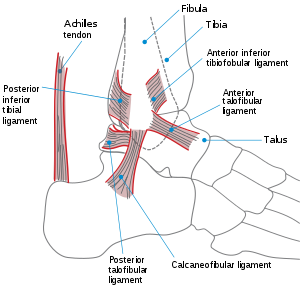Ankle sprains happen when the strong ligaments supporting the ankle stretch beyond their limits, resulting in tears. They can be mild to severe, depending on the damage to the ligaments. Ankle sprains are very common foot injuries that occur among people of all ages.

Lateral view of the human ankle. By An svg version of image:Ankle.PNG by me (Jak). [Public domain], via Wikimedia Commons
1. Approximately 1 million ankle injuries occur each year, and 85 percent of them are sprains.
2. Ankle sprains account for around half of all sports injuries.
3. It is estimated that sprained ankles constitute up to 30% of injuries seen in sports medicine clinics.
4. Ankle injuries are the most common type of injury in US high school athletes, with almost 80,000 occurring in basketball players annually.
5. Acute ankle injury is one of the most common injuries in athletes and sedentary persons. Around 2 million injuries are seen per year and 20 percent of all sports injuries in the United States.
6. Average ankle sprains for the general U.S. population are estimated at 6 ankle sprains for every 1000 person-years. A study showed that military cadets incidences for ankle sprains were about 10X those of the general population
Sports Commonly Affected by Ankle Sprain Injuries
1. Certain sports, including football, basketball, soccer, running and dancing trigger more foot and ankle injuries because the feet are the points of contact.
2. Basketball. According to the Academy of Orthopaedic Surgeons, 41% of all sports-related ankle sprains are basketball related.
3. Football. Ankle sprain is one of the most common injuries in football. This usually happens when the ankle is twisted inwards. Taping and bracing can help reduce the risk of ankle sprains.
4. Soccer. Ankle sprains are estimated to account for up to 29% of all soccer injuries. Stepping on uneven ground or landing on another player’s foot are common causes for this type of injury.
5. Running. Ankle sprains are a common and painful nuisance to a runner. Uneven pavements or trails and wet or icy surfaces in winter, are more likely to cause a misstep and for your ankle to roll.
6. Competitive dancing. Dancing pushes the body to its limit. If you roll on your ankle, you can injure the ligaments that hold the joint together. Most sprains involve the lateral ligamentous structures and result from forced inversion of the hind foot as the dancer lands from a jump.
Grading of Ankle Sprain
The physician will grade the ankle sprain according to the damage to the ligament, whether simply stretched or slightly torn to completely torn.
Grade I – Mild ankle sprain. This is stretching or slight tearing of the ligament with mild tenderness, swelling, and stiffness. The ankle feels stable. One can walk with minimal pain.
Grade II – Moderate ankle sprain. This involves a larger but incomplete tear. Grade II sprain is accompanied by moderate pain, swelling, and brusing. The ankle feels stable but walking is painful.
Grade III – Severe ankle sprain. This involves a complete tear of the affected ligament/s. It is accompanied by severe swelling and bruising. The ankle is unstable, walking is almost impossible because there is intense pain.
Treatment for Ankle Sprain
The treatment for a sprained ankle depends on the severity of injury.
A. Nonsurgical
1. Over-the-counter medications. For most ankle sprains, pain relievers such as ibuprofen, acetaminophen, or naproxen is enough to manage the pain. Recovery follows after adequate resting of the injury.
2. The RICE method. Follow the RICE protocol ASAP after injury – REST your ankle, apply ICE to keep the swelling down, COMPRESS and immobilize the ankle, ELEVATE the ankle above the level of your heart for the first 48 hours.

A brace offering moderate support and compression for a Grade I ankle sprain. By Whoisjohngalt [GFDL (http://www.gnu.org/copyleft/fdl.html) or CC BY-SA 4.0 (http://creativecommons.org/licenses/by-sa/4.0)], via Wikimedia Commons
4. Use of crutches for a couple of days until the swelling and pain subside.
5. Ankle taping to limit motion and proprioception. Its effectiveness depends on the expertise of the individual who performs the taping.
6. Physical therapy to prevent stiffness and improve ankle strength.

Rehabilitation Exercises for an ankle sprain. By Jackhammer21 (Camera, in my room Previously published: nowhere) [GFDL (http://www.gnu.org/copyleft/fdl.html) or CC BY-SA 3.0 (http://creativecommons.org/licenses/by-sa/3.0)], via Wikimedia Commons
B. Surgical Management of Chronic Ankle Sprains
Oftentimes, ankle sprains result in stretching and small tears of the ligaments. While most of these injuries recover fully, sometimes the ligaments do not heal properly resulting in a feeling of instability and ‘giving way’, which may lead to recurrent ankle sprains. Reconstruction of the ligaments involves tightening them to help regain stability.
Lateral Ankle Ligament Reconstruction to stabilize the ankle and relieve any pain associated with an unstable ankle.
1. Brostrom-Gould procedure is usually performed as an outpatient. Postoperative recovery for this procedure includes approximately one month in a non-weight-bearing short leg cast, followed by 2-3 weeks of protective weight-bearing in a brace.
2. The second type of surgical procedure is referred to as a tenodesis procedure. Postoperative convalescence includes 6 weeks of non-weight-bearing in a short leg cast.
——–
Serving Southwest Florida Since 2005, Family Foot & Leg Center has 9 convenient locations throughout Collier, Lee, Charlotte, and Sarasota Counties. Offering pediatric to geriatric family care: Ingrown Toenails, Heel Pain, Bunions, Foot / Ankle Arthritis Pain, Plantar Fasciitis, Foot / Ankle Surgery, Custom Orthotics, and Diabetic Wound Care. In office X-rays, ultrasounds, and minor surgical suite exam rooms. Practice powered by EMR and advanced technologies. Home of the Lam Minimal Invasive No-Scar Bunion Surgery! Come Discover Why Patients Love Our 5-Star Foot & Ankle Care! Same Day Appointments! Easy Online Appointment Scheduling!